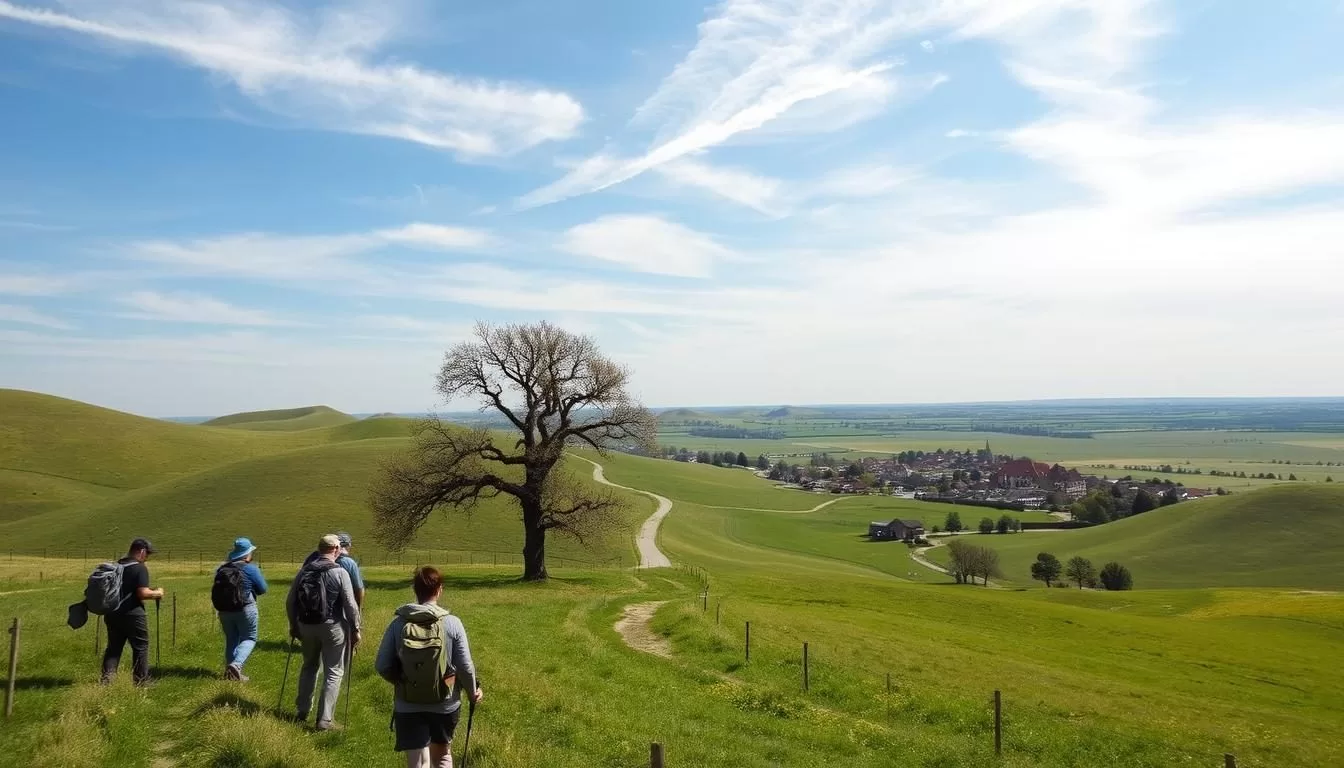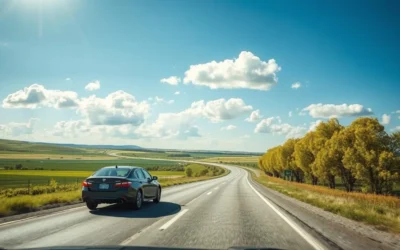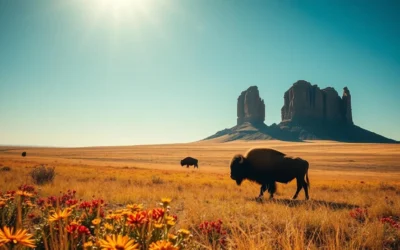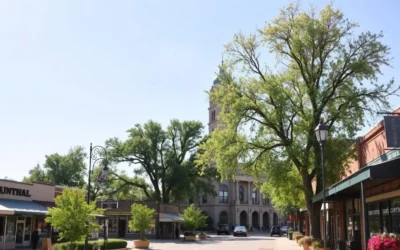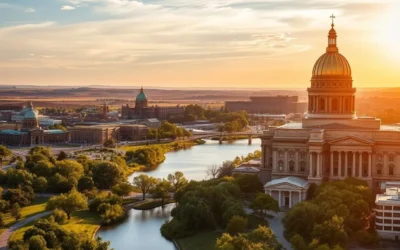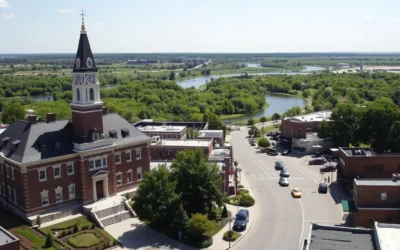✓ Accommodations✓ Flights✓ Rental Cars✓ Tours & Activities
Planning a trip to Nebraska can be a delightful experience, especially when you time it right. The state’s diverse climate means that each season brings its unique charm and attractions. Understanding Nebraska’s continental climate is key to making the most of your visit.
Whether you’re looking forward to enjoying the beautiful fall foliage, the pleasant spring weather, or the warmth of summer, your trip can be tailored to your preferences. This guide will help you determine the best months to visit based on weather patterns and seasonal attractions, ensuring that your experience in Nebraska is nothing short of exceptional.
By considering your priorities, you can make the most of your trip and enjoy the activities and experiences that Nebraska has to offer.
Understanding Nebraska’s Climate
Nebraska’s diverse weather patterns make it essential to grasp its climate characteristics. Located in the Midwest, Nebraska experiences a classic continental climate with four distinct seasons.
Climate Characteristics
The state’s continental climate is marked by hot summers and cold winters, with relatively short spring and fall seasons. This creates distinct weather patterns throughout the year.
- Significant temperature variations occur between seasons and even within the same day due to its location in the Great Plains.
- Nebraska’s inland position results in more extreme temperature swings compared to coastal states.
- Humidity levels vary, with summer months being more humid than the drier winter months.
Understanding these climate characteristics will help you prepare for your visit and choose the best time to visit based on your weather preferences.
| Season | Characteristics | Temperatures |
|---|---|---|
| Spring | Mild, transitioning from winter to summer | 40s-60s°F (7-20°C) |
| Summer | Hot, humid | 70s-90s°F (20-32°C) |
| Fall | Cool, transitioning to winter | 40s-60s°F (7-20°C) |
| Winter | Cold, dry | 10s-30s°F (-12 to 0°C) |
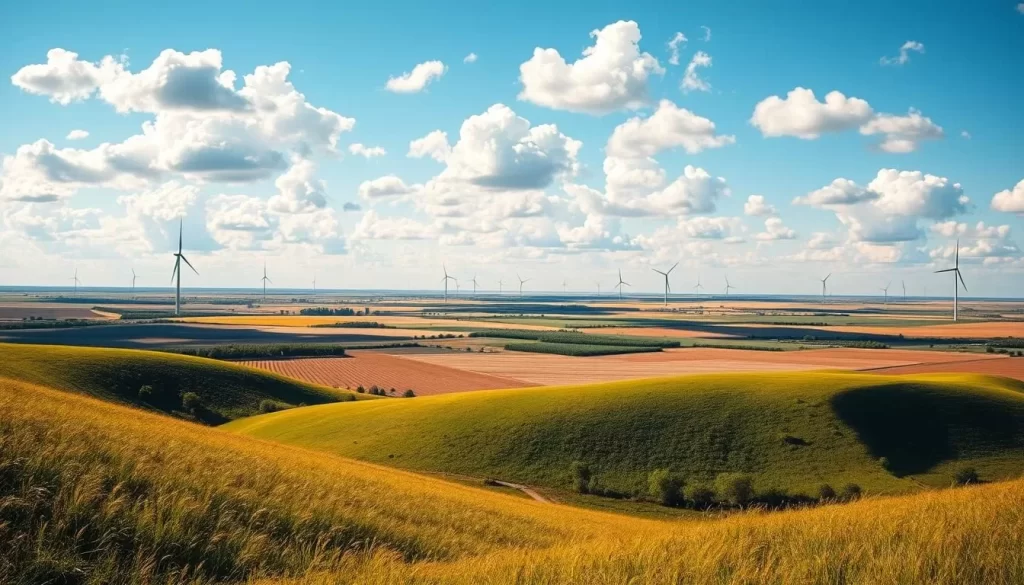
Spring in Nebraska: March to May
If you’re looking for a mix of pleasant weather and exciting outdoor adventures, spring in Nebraska is a great choice. During this time, the state transforms into a vibrant landscape, offering a unique blend of mild temperatures and exciting events.
Weather Patterns and Temperatures
The weather in Nebraska during spring is typically mild, with temperatures ranging from the 50s to 70s Fahrenheit (10 to 25 degrees Celsius). As spring progresses, the state experiences a gradual warming trend.
- Mild temperatures make spring an ideal time for outdoor exploration.
- Temperature fluctuations are common, with potential for both warm days and occasional cold snaps.
- Rainfall increases in late April and May, contributing to the state’s lush greenery.
Here’s a brief overview of the weather patterns during the spring months:
| Month | Average Temperature (°F) | Average Rainfall (inches) |
|---|---|---|
| March | 50-60 | 2-3 |
| April | 60-70 | 3-4 |
| May | 70-80 | 4-5 |
Spring is an excellent time to enjoy outdoor activities in Nebraska, with comfortable weather conditions making it ideal for exploration. As the weather can be unpredictable, it’s essential to pack layers and be prepared for occasional rain showers.
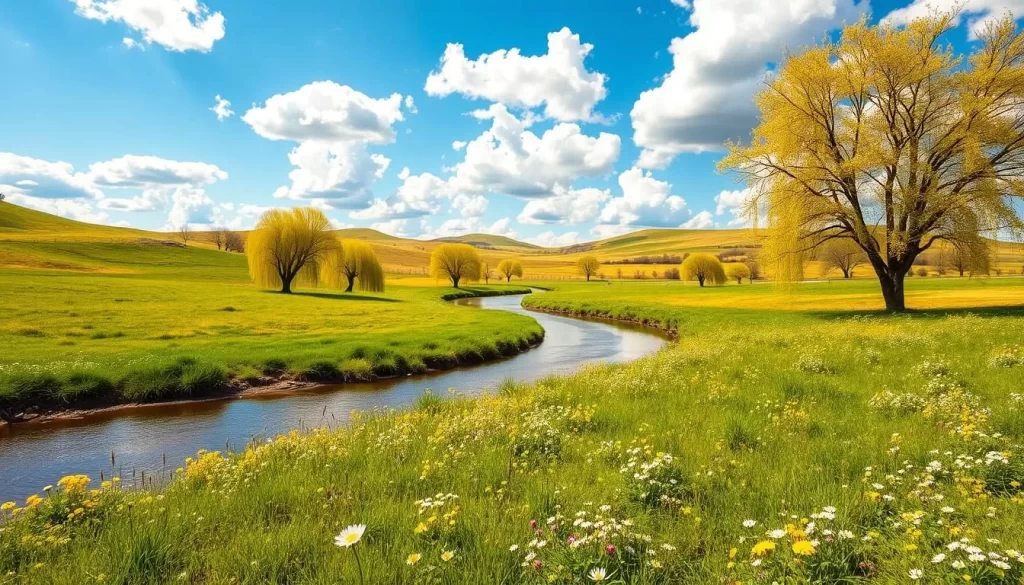
Summer in Nebraska: June to August
Nebraska’s summer season, spanning from June to August, offers a vibrant atmosphere with numerous festivals and outdoor activities. You can enjoy warm weather and long daylight hours, making it ideal for outdoor exploration.
Weather Conditions and Heat Index
During these months, Nebraska experiences hot and humid weather, with temperatures often reaching the 80s and 90s Fahrenheit. The summer season is characterized by warm to hot temperatures, with July being the hottest month.
Key characteristics of Nebraska’s summer include:
– Warm to hot temperatures, with July typically being the hottest month when temperatures can exceed 90°F (32°C).
– Increased humidity levels, making the heat index feel higher than the actual temperature reading on particularly muggy days.
– Common afternoon thunderstorms providing brief relief from the heat but sometimes bringing intense rainfall and occasional severe weather.
– Despite the heat, summer offers the most reliable weather for outdoor activities, with long daylight hours and generally sunny conditions between storm systems.
By understanding the heat patterns, you can plan your daily activities to avoid the most intense midday sun while still enjoying Nebraska’s summer offerings.
Fall in Nebraska: September to November
Nebraska’s fall season offers a unique blend of comfortable temperatures and breathtaking foliage, making it a great time to explore the state. As the summer heat fades, the landscape transforms into a vibrant tapestry of autumn colors.
Temperature Ranges and Foliage
The fall season in Nebraska is marked by temperatures ranging from the 50s to 70s Fahrenheit (10 to 25 degrees Celsius), creating ideal weather for outdoor activities. The state’s parks and surrounding areas display stunning autumn colors, making it a picturesque time to visit.
- Fall brings a welcome relief from summer heat, with September still warm but October and November offering progressively cooler temperatures.
- Nebraska’s fall foliage typically peaks in mid-October, with spectacular displays of red, orange, and gold across the state’s parks and forests.
- The season features dramatic temperature variations, with warm afternoons giving way to chilly evenings as fall progresses.
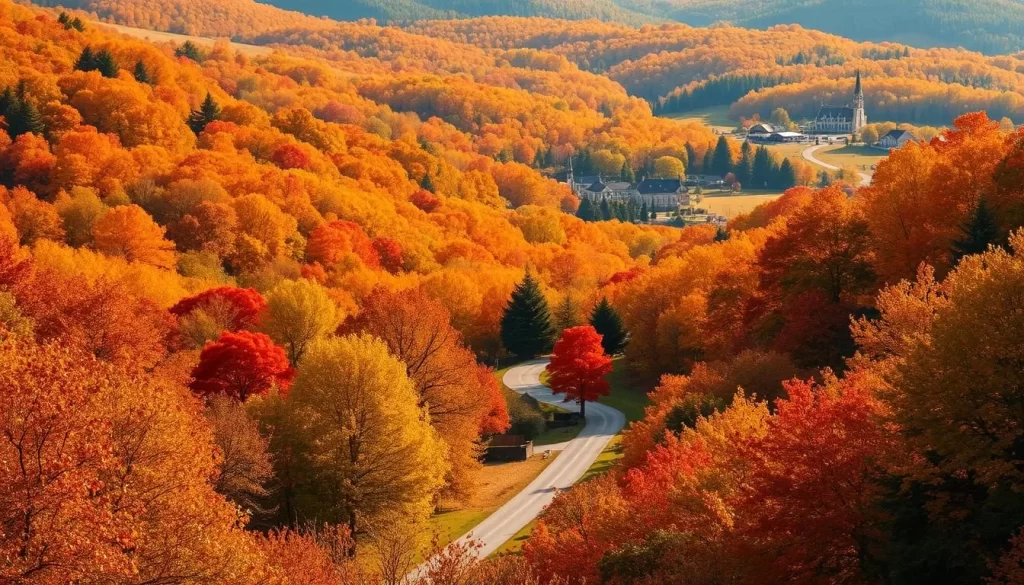
As the season progresses, rainfall decreases compared to summer, creating more stable and predictable weather patterns that are ideal for exploring the city and its surroundings. The first frost usually arrives by late October, and November occasionally brings the season’s first light snowfall, especially in northern parts of the state. Overall, fall is an excellent time to visit Nebraska, with comfortable daytime temperatures and lower humidity making it one of the most pleasant seasons for experiencing the state’s outdoor attractions.
Winter in Nebraska: December to February
As the calendar flips to December, Nebraska transforms into a winter wonderland, inviting you to experience its chilly charm. Winter in Nebraska can be cold and snowy, with temperatures dropping below freezing. If you’re a fan of winter sports and cozy indoor activities, Nebraska offers opportunities for ice skating, sledding, and exploring indoor attractions like museums and art galleries.
Nebraska winters are characterized by cold weather, with January typically being the coldest month when readings can drop well below freezing, especially at night. Snowfall varies across the state, with an average annual snowfall of 25-35 inches in most regions, though amounts can fluctuate significantly from year to year.
Snow Conditions and Cold Weather Preparedness
The winter season brings occasional weather conditions that can lead to blizzard-like situations, especially in rural areas. Clear winter days can be surprisingly sunny despite the cold. Make sure to dress warmly and be prepared for potential winter conditions during these months.
Nebraska, United States: Best Months for a Weather-Savvy Trip
The best months to visit Nebraska are those that offer pleasant weather and exciting outdoor activities. If you’re planning a trip, you’ll want to consider the time of year that suits your preferences.
April to May: Spring Sweet Spot
April and May are considered ideal months to visit Nebraska. During this period, the state experiences mild temperatures, ranging from 60-75°F (15-24°C), making it perfect for outdoor exploration. The spring season brings blooming flowers and lush greenery, creating picturesque landscapes throughout the state.
- The weather is pleasant, with comfortable temperatures and fewer rainy days.
- Nebraska’s parks and gardens are in full bloom, offering beautiful scenery.
- It’s an ideal time for outdoor activities before the summer heat sets in.
- You can enjoy a more relaxed experience at popular destinations due to fewer tourists.
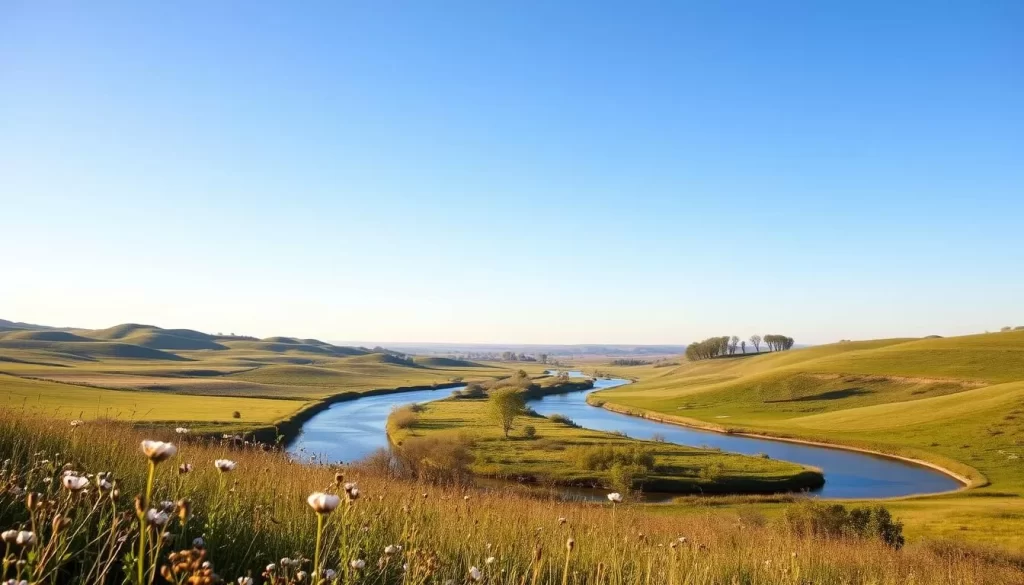
Visiting Nebraska during April and May allows you to enjoy the state’s natural beauty without the peak season crowds, making it the perfect time for a weather-savvy trip.
Exploring Omaha’s Weather-Based Attractions
When planning a trip to Omaha, considering the weather can enhance your experience at the city’s outdoor and indoor attractions. Omaha is home to a variety of outdoor activities and parks that are enjoyable during certain times of the year.
Henry Doorly Zoo and Aquarium: Best Visiting Months
The Henry Doorly Zoo and Aquarium is one of Omaha’s must-visit destinations, offering a unique experience for animal lovers. The zoo provides different experiences throughout the year, with late spring and early fall being the most comfortable times to explore both indoor and outdoor exhibits.
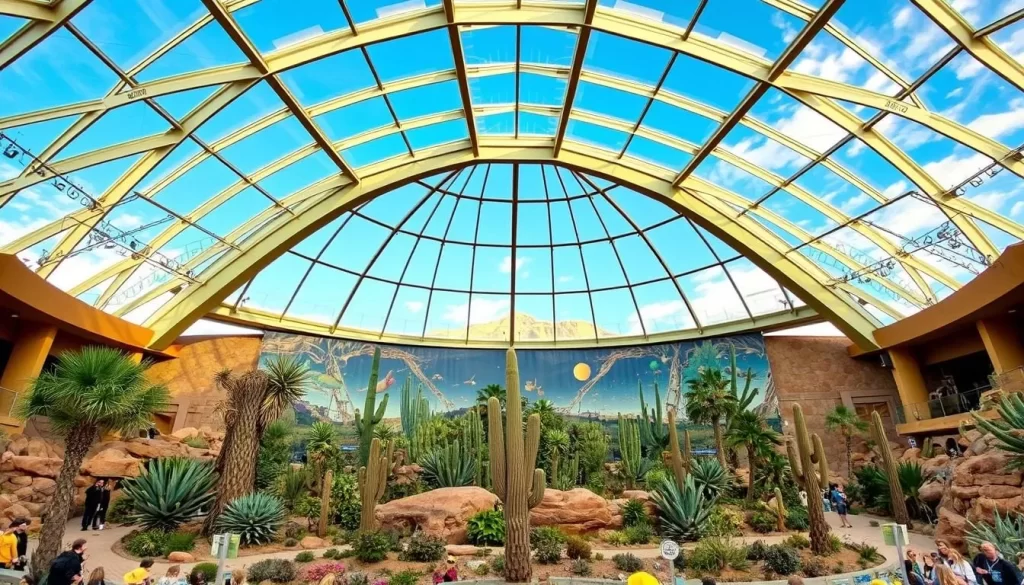
Some key experiences at the zoo include:
- Late spring and early fall provide the most comfortable weather for exploring exhibits.
- Summer months allow for all outdoor attractions but can be crowded and hot.
- The Desert Dome and indoor exhibits are available year-round.
- Winter visits offer a unique perspective with fewer crowds.
- Special seasonal events provide entertainment throughout the year.
- The adjacent Lauritzen Gardens offers complementary botanical experiences.
Planning your visit according to the season can greatly enhance your experience at the Henry Doorly Zoo and Aquarium.
Lincoln’s Seasonal Highlights
Lincoln, Nebraska, is a city that transforms with the seasons, offering a unique experience throughout the year. As the weather changes, the city’s parks and gardens become vibrant with color, making it an ideal time to visit attractions like Sunken Gardens.
During the spring and early summer, Sunken Gardens is a must-see. The gardens burst into bloom, creating a spectacular display of flowers.
Sunken Gardens: Peak Blooming Seasons
The peak blooming season at Sunken Gardens typically occurs from late May through June, with thousands of annual flowers on display. This beautiful garden is a highlight of Lincoln’s seasonal attractions, offering a unique experience during its prime growing season.
Nebraska’s Natural Wonders Through the Seasons
Nebraska’s varied natural wonders are at their most captivating when viewed across different seasons. You can experience the state’s diverse landscapes in unique ways throughout the year.
Sandhill Crane Migration: March Spectacle
The Sandhill Crane migration in March is a breathtaking spectacle, with over 80% of the world’s Sandhill Crane population gathering along Nebraska’s Platte River. This wildlife phenomenon is weather-dependent, peaking in mid-March. You can witness over half a million sandhill cranes during their migration.
The Crane Watch Festival in March is a notable event, celebrating this natural wonder. The best time to visit for this experience is late February to mid-March.
Nebraska offers various outdoor activities across the seasons. The Niobrara River is ideal for canoeing and tubing from late spring to early fall. The dramatic rock formations of western Nebraska, like Chimney Rock and Scotts Bluff National Monument, change with the seasons, offering different experiences.
The Sandhills region transforms seasonally, from winter’s stark beauty to summer’s green hills dotted with wildflowers. You can enjoy seasonal wildlife viewing, including prairie chickens’ spring mating displays and fall bird migrations along the Central Flyway.
Weather-Based Packing Tips
Packing for a trip to Nebraska requires careful consideration of the state’s variable weather. To ensure a smooth and enjoyable travel experience, it’s essential to be prepared for the season you’re visiting in.
You should choose your clothes wisely for all seasons in Nebraska. For spring and fall, wear layers to adapt to the changing weather, and don’t forget a rain jacket. In summer, opt for light, airy clothes, while winters require warm coats, hats, and boots. Sunscreen and hats are a must year-round.
Spring and Fall Essentials
For spring and fall visits, layering is key due to the fluctuating temperatures. Pack a waterproof jacket, light layers, and comfortable shoes. In fall, add a warmer jacket for cool evenings.
- Pack layers for spring and fall to adjust to temperature fluctuations.
- Bring a waterproof jacket and comfortable shoes for potentially muddy conditions.
- In summer, focus on lightweight, breathable fabrics and sun protection.
- For winter, include comprehensive cold-weather gear like insulated boots and warm hats.
Accommodation Choices by Season
When planning your trip to Nebraska, choosing the right accommodation can greatly enhance your travel experience. The state’s diverse range of accommodations caters to different preferences and seasonal needs, ensuring that you find the perfect fit for your time visit.
Urban Hotels vs. Rural Retreats
Urban hotels in Nebraska offer convenient access to indoor attractions, making them ideal during winter months when weather might limit outdoor activities. In contrast, rural retreats provide a serene escape, showcasing the state’s natural beauty during the peak growing season in summer.
Accommodation pricing fluctuates seasonally, with higher rates during summer and special events. In contrast, winter months (excluding holiday periods) typically offer the best values for budget-conscious travelers. Consider amenities like indoor pools, covered parking, and on-site dining to enhance your stay.
| Season | Accommodation Type | Recommended Amenities |
|---|---|---|
| Winter | Urban Hotels | Indoor pools, covered parking |
| Summer | Rural Retreats | Outdoor pools, proximity to parks |
| Spring/Fall | Bed & Breakfasts | Fireplaces, scenic views |
Booking in advance is crucial, especially during major events like the College World Series or football weekends, when accommodations fill quickly. By choosing the right accommodation for your travel needs, you can ensure a memorable experience in Nebraska.
Transportation Considerations
When planning your trip to Nebraska, understanding the transportation options is crucial. Nebraska offers various ways to get around, including public transportation, rental cars, and rideshare services.
Road Conditions Throughout the Year
Nebraska’s road conditions vary significantly by season. Winter presents the greatest challenges due to potential snow and ice, particularly on rural highways and secondary roads.
The Nebraska Department of Transportation provides real-time updates on road conditions, construction, and weather-related closures. For winter travel, consider renting an all-wheel drive vehicle for better traction. In contrast, convertibles or economy cars are suitable for summer exploration of scenic byways.
- Public transportation is mainly available in Omaha and Lincoln, with limited rural access.
- Airport operations at Omaha’s Eppley Airfield and Lincoln Airport can experience weather-related delays, so it’s advisable to build flexibility into your travel plans.
- Rideshare services like Uber and Lyft operate primarily in urban areas, providing convenient transportation during inclement weather.
Local Events Calendar: Planning Around Weather
To make the most of your trip to Nebraska, consider planning your visit around the state’s most significant events and festivals. Nebraska’s event calendar is filled with exciting activities throughout the year, influenced by the weather.
Major Annual Festivals
Nebraska hosts several major annual festivals, including the Nebraska State Fair in late August/early September, which showcases livestock exhibitions, concerts, and remarkable food. The Nebraska Balloon & Wine Festival in August is another highlight, featuring hot air balloons and wine tastings.
Nebraska’s events are primarily concentrated in the warmer months from May through September when weather conditions are most reliable. When planning your time to visit, consider the typical weather for that time of year and indoor backup options in case of unexpected weather changes. You’ll find a variety of things to do and experience in Nebraska, from outdoor celebrations to indoor entertainment options.
Conclusion
The Cornhusker State’s climate is as diverse as its attractions, making weather a crucial factor in planning your weather-savvy trip to Nebraska.
Nebraska offers distinct experiences across all four seasons, with the best months for a visit generally falling in late spring and early fall. During these periods, temperatures are moderate, and outdoor activities are most enjoyable.
Your trip to Nebraska can be tailored to your preferences, whether that’s witnessing wildlife migrations, enjoying harvest festivals, or participating in winter sports. By understanding the state’s weather patterns, you can plan your trip accordingly, packing appropriately and choosing suitable accommodations.
Nebraska’s hospitality shines year-round, with locals ready to welcome visitors and share insider tips on making the most of your visit. Whether you’re looking for the perfect time to enjoy the state’s natural wonders or cultural attractions, understanding Nebraska’s climate will help you create memorable experiences.
In conclusion, a weather-savvy trip to Nebraska involves considering the best months to visit based on your interests and preferences, ensuring a memorable and enjoyable experience.
The above is subject to change.
Check back often to TRAVEL.COM for the latest travel tips and deals.
